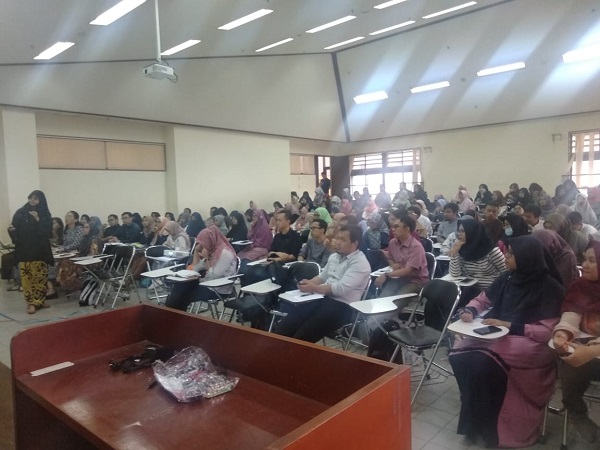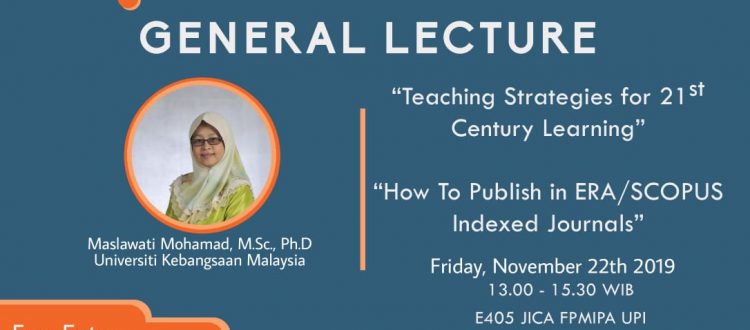General Lecture from Maslawati Mohamad, M.Sc., Ph.D., Universiti Kebangsaan Malaysia
Bandung, 22 November 2019
IPSE conducted a general lecture How to Publish in ERA/SCOPUS Indexed Journals on Friday the 22nd of November 2019 starting from 1 p.m. A hundred and thirty-five participants from Universiti Kebangsaan Malaysia, several departments in FPMIPA UPI, English department and Sekolah Pascasarjana UPI participated in the event. The keynote speaker was Maslawati Mohamad, M.Sc., Ph.D. a lecturer from University Kebangsaan Malaysia. The event was guided by Ikmanda Nugraha, M.Pd.

The speaker provided insights on the importance of publication for all academicians. Students and lecturers were recommended that they publish their research findings. By means of publishing the findings, students, lecturers, and researchers can share their idea as well as building networking to develop their expertise. To begin publishing in a reputed journal, writers should find pattern appeared in other relevant research. It is necessary to find proper references so that our paper will meet the appropriate pattern concerning the particular issue.
The first session is about “How to Publish in ERA/SCOPUS Indexed Journals”. Mrs Maslawati Mohamad, M.Sc., Ph.D explain about types of publication, which is shown by a pyramid, the highest and the most difficult is an indexed journal. The indexed journal consists of WoS, ESCI, ERA, and SCOPUS. In this general lecture, the speaker explained more about ERA and SCOPUS. Talking about the journal, can not be separated from Impact Factor (IP). The impact factor is a measure of the frequency with which the average article in a journal has been cited in a particular year. It is used to measure the importance or rank of the journal by calculating the times its articles are cited.
The participants have obtained views about ordered steps to publish a journal article that are:1) find a journal that suits your publication criteria 2) prepare your paper for submission 3) submit and revise 4) track your paper. In addition, common contents of journal articles were also described by the speaker. The speaker explained what it means by title, abstract, introduction, literature review, findings, and discussion, conclusion, acknowledgment, the components that each participant should write in their journal article.
The way to get published can be through attending a conference, send to the journal’s website or by special issue. There are steps to publish journal articles. First, find a journal that suits your publication criteria, to know the pattern, topic and recent issue read the journal’s aim and scope because good references come from credible sources. Second, prepare your paper for submission. Third, submit and revise. Fourth, track your paper. The last, share and promote your paper due to maintain the journal, it has to be well-read, therefore having networking, it can be added value. The published journals also have been selected based on the criteria. Such as quality (content, conceptual advancement, novelty, references WoS or SCOPUS), cited at least two articles from the targeted journal, internationalization authorship, interuniversity authorship, error-free formatting/typesetting, and error-free language.
The second session is started after the break for a few minutes. Maslawati Mohamad, M.Sc., Ph.D. opened the next session with “ice-breaking”. That was very fun because it tested our focus also encourage us to get in touch with another participant. The second session is about Teaching Strategies for 21st Century Learning. She opened our minds by showing the development of industrial revolutions.
The industrial revolution has impacted many aspects of life, one of them is the education field. Based on the observation. There is transformation of education from 1.0 until 4.0. For instance, in education 1.0 used teacher-centered learning. In education 2.0 used social connections and contribution. In education 3.0 used education is cross-cultural and cross-institution. And nowadays education 4.0 used innovative producing education. Therefore, there are four skills which will be increased in education 4.0. There are called 4C (Communication, creativity, critical thinking, and collaboration).
Teaching strategies for the 21st century has the guideline to be implemented in the learning process. It is SMART (Specific, Measurable, Achievable, Relevant, and Time-bound). SMART also combines with the student-centered learning approach. Therefore, teaching strategies for the 21st century must have good collaboration among teachers, parents, pupils, and community industry/resources.
In the last sessions, Mrs. Maslawati Mohamad, M.Sc., Ph.D. opened the question and answer session and closed the general lecturer with a great quote “Long Life Learner”. Overall, the general lectures run well because the participants were enthusiastic about this topic, and ask some questions related to the topic. The participants also feel very insightful after they attend this general lecture, especially increasing knowledge in teaching strategies for 21st-century learning and how to publish in ERA/SCOPUS indexed journals.
(RIKA RAFIKAH AGUSTIN; PUTRI SEKAR MELATI)

